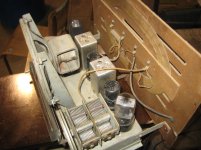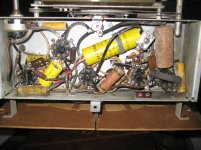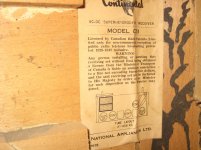Hi, I have a 1947? radio that will still operate but has 60hz hum through the speaker. I realize the old paper-wax capacitors are suspect, but other than the hum, the radio operates very well. Even in it's current state it has much more sensitive reception than the solid state radio I have in my shop. Do I need to do all the caps? Electrolytic caps are fine for replacements?
Here's a couple of pics:



Here's a couple of pics:



First I need to mention that this radio is directly mains operated and can be EXTREMELY hazardous to work on. Please go and purchase an isolation transformer on eBay before going any further.
All of the electrolytic filter caps and paper (waxy looking caps) need to be replaced. Most of these parts can be purchased from places like Antique Electronic Supply LLC and Radio Daze, LLC. - Antique Radio Parts & Service
Radio Daze has a selection of multi-section caps here: Multi-Section
In addition you should add a line fuse for safety, and make sure that the paper cap between AC line and metal chassis if present is replaced with an equal value ceramic or film Y cap.
See here: ABC's of Safety (Interference Suppression) Capacitors for Tube Radios
All of the electrolytic filter caps and paper (waxy looking caps) need to be replaced. Most of these parts can be purchased from places like Antique Electronic Supply LLC and Radio Daze, LLC. - Antique Radio Parts & Service
Radio Daze has a selection of multi-section caps here: Multi-Section
In addition you should add a line fuse for safety, and make sure that the paper cap between AC line and metal chassis if present is replaced with an equal value ceramic or film Y cap.
See here: ABC's of Safety (Interference Suppression) Capacitors for Tube Radios
Hi,
I note the label seems to imply it can run from DC ? use a DC supply ?
rgds, sreten.
Better to replace all of those 65yr old capacitors IMO..
It's obviously an "All American 5" radio, and you can you can Google that name and find schematics and descriptions online. It runs directly on the 120V AC line, and will also run on 120V DC with the correct polarity so that the current goes through the half-wave rectifier tube to give plate voltage to the other tubes. 120V DC was rare, but I heard decades ago it was available on cruise ships.Hi,
I note the label seems to imply it can run from DC ? use a DC supply ?
rgds, sreten.
That should be fine, as electrolytics back then were +/- 20 percent on a good day.I'm having trouble finding a multi section tubular cap like the one in the radio. It's a 60/30 uf, would a 47/33 uf be adequate?
Here is a possible option: Capacitor - Electrolytic, 33/33/47 µF @ 160 VDC | Antique Electronic Supply LLC you can wire the two 33uF sections in parallel for 66uF, and the second section is 47uF.. Should result in a quieter radio..
I suspect one of those horrible paper caps is connected directly from one side of mains to the chassis - most unusual if this is not the case.
Make sure you get an actual isolation transformer as noted in a previous post, small medical grade units are cheap on eBay and will fit the bill nicely.
I suspect one of those horrible paper caps is connected directly from one side of mains to the chassis - most unusual if this is not the case.
Make sure you get an actual isolation transformer as noted in a previous post, small medical grade units are cheap on eBay and will fit the bill nicely.
It's obviously an "All American 5" radio, and you can you can Google that name and find schematics and descriptions online. It runs directly on the 120V AC line, and will also run on 120V DC with the correct polarity so that the current goes through the half-wave rectifier tube to give plate voltage to the other tubes. 120V DC was rare, but I heard decades ago it was available on cruise ships.
<snip>
Manhattan had 110VDC in some neighborhoods well into the 1950s, as did a number of other places in the USA that were electrified late in the 19th century. Equally odd was the 25Hz power used in upstate NY and parts of the midwest until around the same time. (I have an Atwater Kent radio that was designed for 25Hz power, must have buzzed a bit although it is fairly quiet on 60Hz..)
Thanks for the info guys, interesting read about the AA5 radios too. I order the caps from tubesandmore and I'll make sure to get an actual isolating transformer. I know enough not to plug it in with the chassis exposed, but you know, there's a screw in the bottom that retains the chassis that could've given me a lifter when I was moving this thing around.
An interesting set, and yes do get an isolation trafo before you work on this death trap.
Those chocolate bar looking capacitors should still be okay tho.
I've noticed one other thing aswell, it doesn't have a mains fuse, you might want to consider putting one in! because if the rectifier ever has an internal short, and you are away from the set at the time, the rectifier tube will melt on its foundation inside of the socket, I've seen this happen before.
Oh and watch out for the minister. Thieving bastard will make up any reason to take $25 from us...
Those chocolate bar looking capacitors should still be okay tho.
I've noticed one other thing aswell, it doesn't have a mains fuse, you might want to consider putting one in! because if the rectifier ever has an internal short, and you are away from the set at the time, the rectifier tube will melt on its foundation inside of the socket, I've seen this happen before.
Oh and watch out for the minister. Thieving bastard will make up any reason to take $25 from us...
Last edited:
Part of NYC's Greenwich Village had DC house current into the 1970s. As those those areas are near Washington Square Park, where Edison did his initial incandescent lighting demonstration, it's not too far fetched to believe Tom's equipment was still at work.
As for 25 Hz. power, it was used in combination with rotary converters to provide the 600 VDC subways run on. Tesla strikes again! Mechanical conversion was easier at 25 Hz. than at 60 Hz.
Mechanical conversion was easier at 25 Hz. than at 60 Hz.
Devil take "E-Pay"! An inexpensive Triad N-68X from Mouser or Allied will do yeoman duty in the isolation trafo role. Power the 150 mA. series heater string with AC from the secondary. To avoid the issue of "standing" DC associated with 1/2 wave rectification causing trouble in the isolation trafo, bridge rectify the AC with 4X UF4007s and filter with a 100 μF./250 WVDC 'lytic. Use the vacuum rectifier as a "soft" start device. Finally, the isolation trafo allows for the installation of a safety grounded, 3 wire, power cord. Absolutely no "Death Cap." on the primary side of the N-68X.
As for 25 Hz. power, it was used in combination with rotary converters to provide the 600 VDC subways run on. Tesla strikes again!
Devil take "E-Pay"! An inexpensive Triad N-68X from Mouser or Allied will do yeoman duty in the isolation trafo role. Power the 150 mA. series heater string with AC from the secondary. To avoid the issue of "standing" DC associated with 1/2 wave rectification causing trouble in the isolation trafo, bridge rectify the AC with 4X UF4007s and filter with a 100 μF./250 WVDC 'lytic. Use the vacuum rectifier as a "soft" start device. Finally, the isolation trafo allows for the installation of a safety grounded, 3 wire, power cord. Absolutely no "Death Cap." on the primary side of the N-68X.
If the line voltage is greater than what the heater voltages add up to, I think I'd put a resistor in series with the heater chain to drop the difference. This would also lower the peak current when first turned on, and help prevent a heater from burning out from that or from overvoltage.
I was thinking the 50L6GT surely had a lower heater current rating than the 35L6GT, but according to the nearest RCA manual, indeed they both say 0.15A and they're both designed for these series-heater "AC/DC radio receivers."
The heater voltage sum of 121V is indeed a better match for today's line voltage than 106V, but I still like the idea of some small resistance dropping a few volts from the heater chain for the reasons I give above.
I was thinking the 50L6GT surely had a lower heater current rating than the 35L6GT, but according to the nearest RCA manual, indeed they both say 0.15A and they're both designed for these series-heater "AC/DC radio receivers."
The heater voltage sum of 121V is indeed a better match for today's line voltage than 106V, but I still like the idea of some small resistance dropping a few volts from the heater chain for the reasons I give above.
Last edited:
I'd do the electrolytic caps immediately, but I'd measure the paper caps or operate it and look for a symptom before replacing. Except the one between line & chassis, that should be Y rated by UL or CSA. I don't have a lot of trouble with old paper caps. But, paper caps stessed over about 40 v go out more than lower voltage ones. The electrolytic caps have a plus on one end and are over 1 uf. My collection is mostly Fomoco car radios and Hammond organs. The biggest problem with car radios is the thermal vibrator for AC. Nah, the biggest problem is the lack of good material on the AM band. Cheap feel good lies about God and cheap feel good lies about politics. I miss KRLD-AM Dallas, the clear channel night classical station. The Louisville WHAS-AM used to be good R&R, too, but now they talk, talk, talk.
Last edited:
Also replace the line cord - it's "fastened" to the chassis by being tied in a knot. Nowadays it needs to have an approved cable clamp to meet code if it's being plugged into the mains. Or you can remove the mains plug and wire it directly into an external supply box containing the transformer, rectifiers, fuse etc suggested by Eli.
Replaced the paper caps (with yellow film caps) and the electrolytics as well. Had to use a 40/80 instead as I couldn't find a 30/60 two-section tube. Tight fit but it's in there now.
A fellow on another site suggested replacing the power cord with a GFI cord from a cheap hair dryer...worthwhile?
I was hoping to maintain as original a look as possible, and still be safe. I've covered the chassis mounting screw with a plastic plug and the old knobs are in fine shape so I don't think anyone could accidentally contact the mains voltage.
A fellow on another site suggested replacing the power cord with a GFI cord from a cheap hair dryer...worthwhile?
I was hoping to maintain as original a look as possible, and still be safe. I've covered the chassis mounting screw with a plastic plug and the old knobs are in fine shape so I don't think anyone could accidentally contact the mains voltage.
- Status
- This old topic is closed. If you want to reopen this topic, contact a moderator using the "Report Post" button.
- Home
- Amplifiers
- Tubes / Valves
- 40's tube receiver question